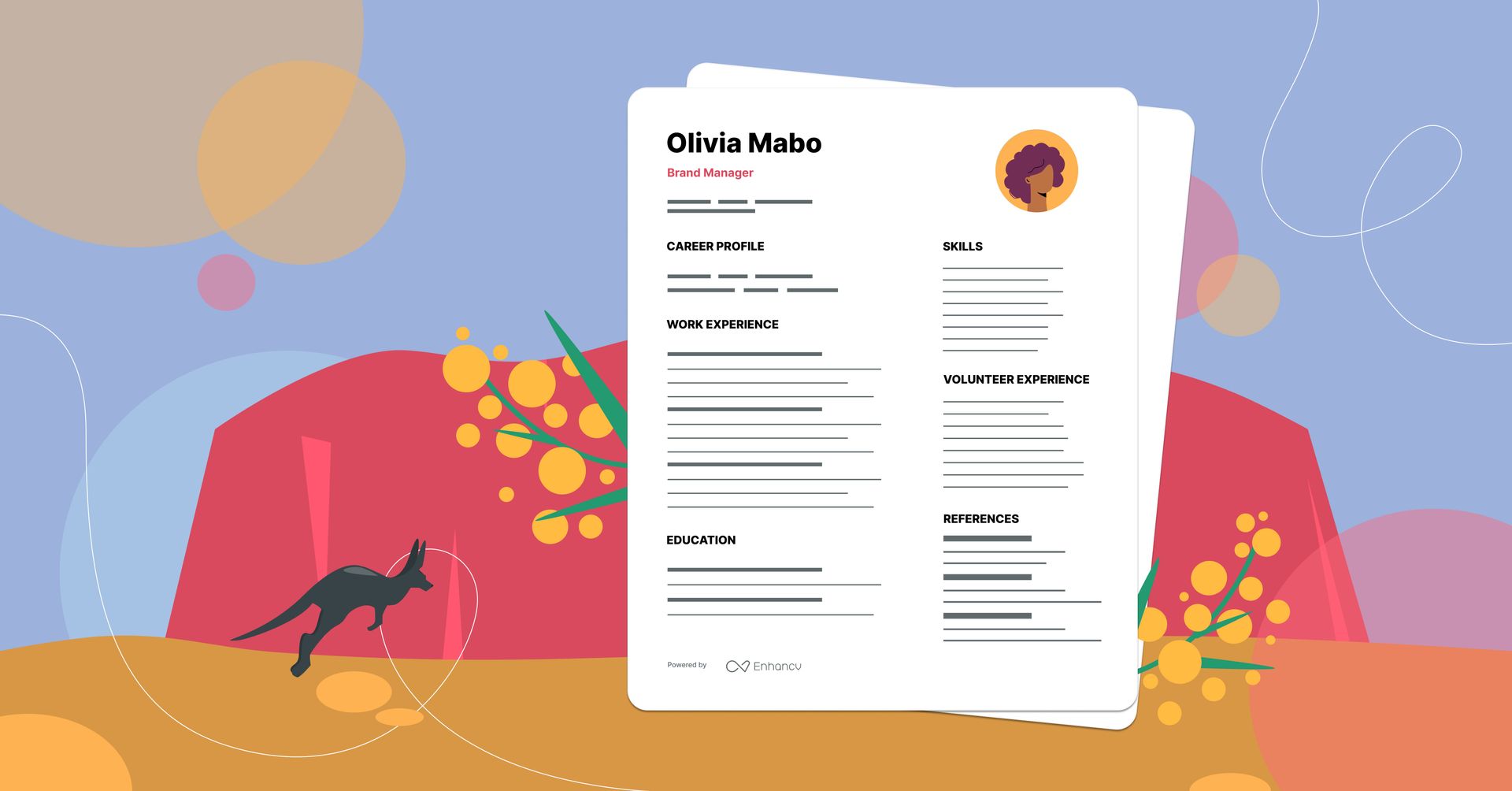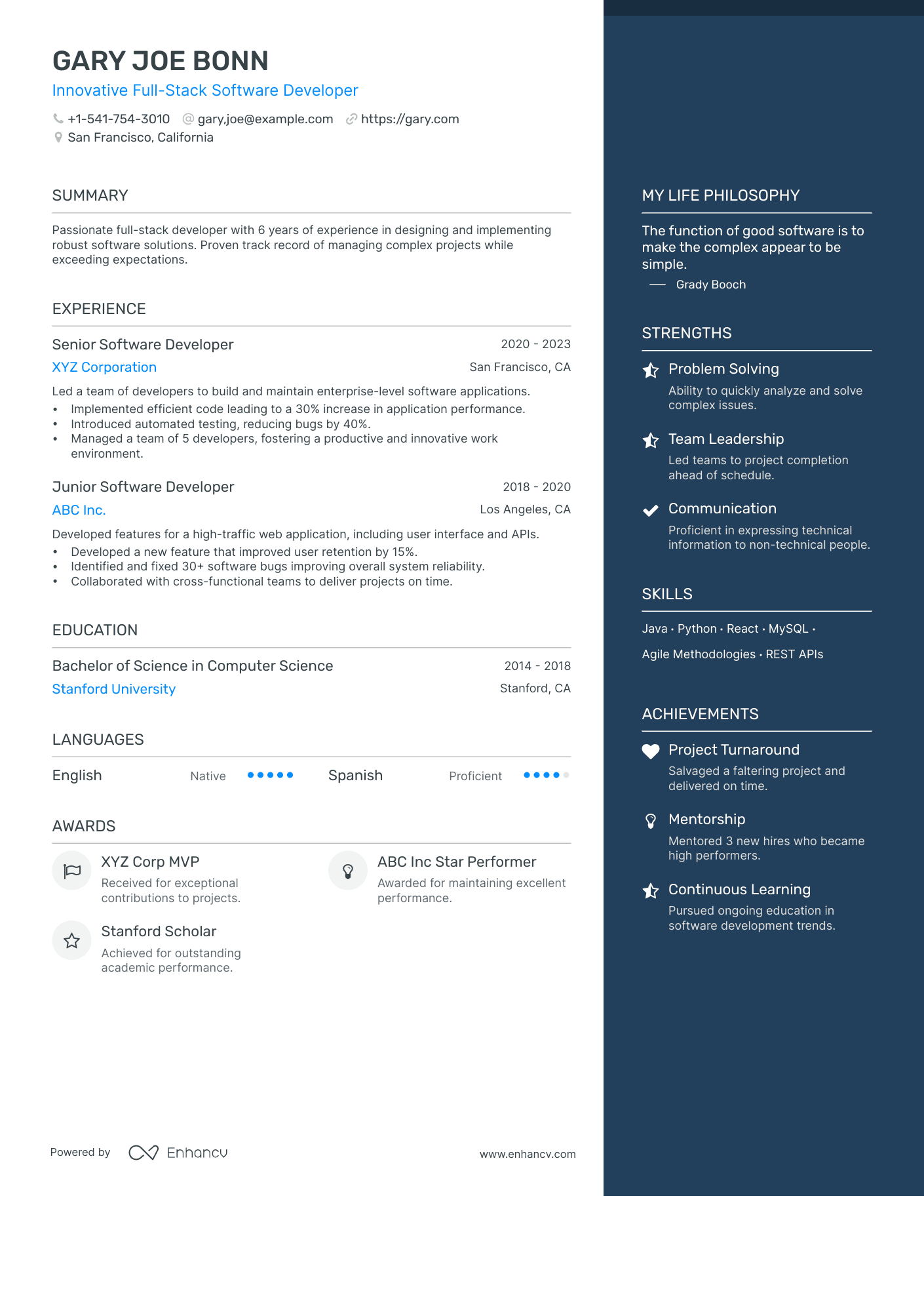Searching for a new job is an ongoing process, but there are ways to decrease the time you spend looking for the ideal position. When you have an outstanding resume, you increase your chances of the hiring managers pulling your document out from the stack of other applicants.
Australia pays a higher minimum wage than the United States, so it’s no surprise that many job seekers want to move to make a better living. Read on to learn how an Australian resume differs from the standard format. You’ll find out what sections you should include to ensure the hiring manager knows you’re the right fit for the job.
Is your resume good enough?
Drop your resume here or choose a file. PDF & DOCX only. Max 2MB file size.
What is an Australian resume format?
An Australian resume looks similar to standard resumes, but there are some key differences you won’t want to miss. For example, skipping details can make the difference between a hiring manager giving you a callback or passing you by for a candidate that paid attention to the specifics.
A resume and a CV are two distinct documents in the United States. However, Australian job postings use the terms interchangeably. Therefore, as long as you have a resume that includes the sections below, you can apply to jobs that ask for a resume or CV with the same document.
Australian resumes are typically three to four pages long, depending on your work experience. New graduates looking for entry-level positions might have a two-page resume. This length differs from the standards in the United States, which ask for a concise one-page document.
What sections to include in your Australian resume
When you’re ready to create your Australian resume, include the following sections. You can put them in different orders depending on your strengths. For example, professionals with plenty of work experience use the reverse chronological format to showcase relevant jobs. New graduates list education first, while people changing careers highlight their skills.
You should follow formatting guidelines regardless of the layout you choose for your Australian resume. Use a dark font so it’s easy to read. Write your resume in correct Australian English to show the hiring manager you can adapt to the language and culture.
Header
Your resume always starts with a header that contains your contact information. You don’t need to include information about your demographic, as that can lead to profiling. You also shouldn’t have much personal information since the rest of your resume will show the hiring manager more about you.
The contact information in the header includes items such as:
- Name
- Address
- Phone number
- Email address
Some applicants may include their website if it’s a professional portfolio of writing samples, photography, or other information relevant to the job posting.
Career Profile
A career profile, also known as an objective or summary, states your career goal. While it’s not a required section, it’s ideal because it shows the hiring manager what you’re looking for in terms of employment. They can read this brief section and know whether you’re a match.
This section can range from one to three sentences long and gives a broad overview of who you are and what you want to do in the position. However, you don’t want to get too detailed because your specific work experience and education come later.
For example, someone fresh out of school can write: “Recent human resources graduate looking for a full-time position in payroll, employee benefits, and performance tracking.”
Someone with years of job history applying for the same position might write: “Human resources professional with over 12 years of experience seeks a role in hiring and onboarding.”
You can see how both objectives give information about the person while showing the hiring manager their intentions. Keep this format in mind as you brainstorm your summary.
Work Experience
Your work experience is an essential part of an Australian resume. This section is your opportunity to show the hiring manager what you’ve accomplished in the past and how you hope to continue in a new position.
The most common way to organize your work experience is in reverse-chronological order. This approach means your most recent job is at the top of the list since it’s where you currently work or the role you just left. From there, you go back through your job history, ending when you hit ten years or reach your first job, whichever comes first.
List your position since the hiring manager needs this information more than anything else. Then include the company name and the dates you worked there. Below this information, list any achievements you accomplished in the role in the form of bullet points.
Use active language in your resume. Instead of bland words like “did” and “tried,” use action verbs, such as:
- Analyzed
- Organized
- Resolved
- Streamlined
These words express more action about your accomplishments and convey your sense of professionalism and productivity to the hiring manager.
Though you have up to four pages to fill, you don’t need to include irrelevant details in this section. For instance, applicants with years of work experience should only go back ten years. If you have relevant experience from jobs over ten years ago, create an additional “Other Professional Experience” section and list the highlights there.
Education
List your education in reverse chronological order, just like your work history. Start with your most recent degree and work backward.
Most professionals only need to include higher education in this section. Include any degree you earned, listing the institution and dates attended. If you accomplished anything outstanding during your education, like Dean’s List or an academic scholarship, mention it.
People seeking entry-level jobs might also include their high school diploma if they have no other education. For example, if you completed Technical and Further Education (TAFE), list it here. Once you attend college, the hiring manager will know you have a high school education, so you don’t need to mention it.
If you’re applying for work and only have a high school diploma, include noteworthy details, like a distinction in a relevant course or membership in a club.
Skills
Your skills include strengths and knowledge you might not mention in your work history or education. These can be hard skills, like with graphic design software or another language. They can also include soft skills, like impeccable communication or time management skills.
If you have different ranges in your skill sets, consider separating them for clarity. You could have a section entitled “Areas of Expertise” separate from “Technical Skills,” showing the hiring manager where you exceed and where you have a working knowledge.
You should include skills that are relevant to the job. In fact, including specific terms from the job listing will help your resume stand out from the crowd. Many employers want to hire someone who
Volunteer Experience
Like skills, the volunteer section is a chance to share additional information about your passions and experience that might impact how well you can perform the job. Even if some volunteer experiences don’t align with the position, showing the hiring manager that you prioritize giving your time to volunteer organizations will make a positive impression.
If you have any gaps in your work history but volunteered during that time, be sure to list the experience in this section. Volunteering is a great way to explain what you were doing when you weren’t officially employed.
References
Hiring managers used to require applicants to list references on their resumes. You could name three professional contacts to verify the information on your resume. However, most hiring managers don’t need references as soon as they read your resume. They make a decision based on the information alone, then call you in for an interview or take you out of the running.
You should have three professional references in your notes, though. You might need to give the information to the hiring manager after your interview if they choose to move you ahead in the process.
Read the job description carefully. Some companies might mention that they want references with the application, so you could add them to your resume. You could also include this section and specify that references are available upon request, though it’s not necessary.
Example Australian resume
Below is an example of an Australian resume that gives you the basic format. Of course, since a professional with an extensive work history should have at least three pages of content, you’ll want to expand from this general foundation, but it’s a great starting point.
First and Last Name
Home Address
Phone Number
Email Address
Career Summary
Graphic designer with ten years of experience seeking to move from print multimedia to advertising campaigns. Expert use of Adobe Creative Cloud.
Work Experience
Print Production Manager at Global Graphics, 2013 to present
- Create logos for over 50 companies based solely on their names and missions
- Design fliers, letterhead, and business cards for local businesses
- Study design briefs to mockup samples and estimate project output
- Conceptualize visuals based on the company’s rough drafts
Education
Bachelor of Fine Arts in Graphic Design, Art University, 2016
Associate of Art in Graphic Design, Graphic Community College, 2013
Skills
- Expert proficiency in Adobe Creative Cloud
- Expert usage of Microsoft Office Suite
- Conversational experience with Spanish
Volunteer Experience
- Deliver meals to the homebound twice a month, Meals on Wheels, 2018 to present
Final thoughts on an Australian resume
Creating an Australian resume isn’t too different from the basic format, so you shouldn’t have trouble spotlighting your experience and education. Make sure you use Australian English and put your best foot forward to stand out from the crowd. Happy job hunting!
Make one that's truly you.




